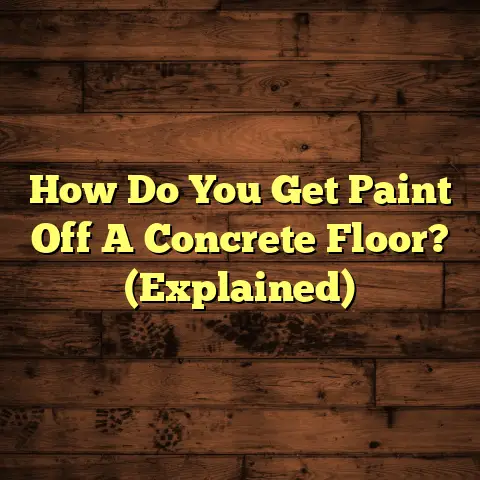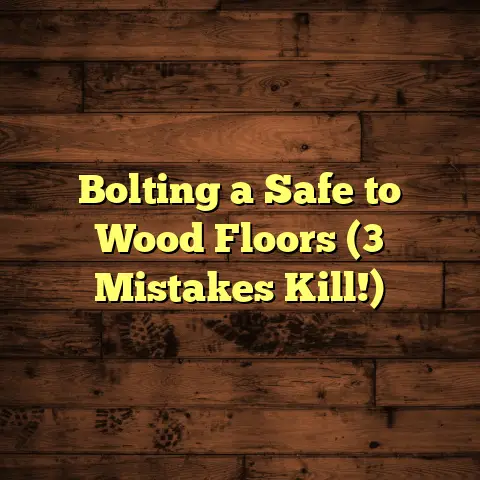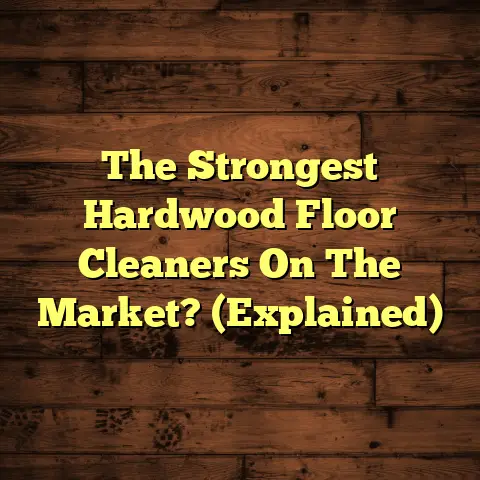Build Shed on Slab? (1 Mistake Ruins Everything!)
Let me tell you a story.
A few years back, I had a client – let’s call him Bob – who was convinced he could build a shed in a weekend.
He envisioned a glorious structure, a haven for his tools, a monument to his DIY prowess.
What he ended up with looked more like a cardboard box after a particularly rough storm.
The roof sagged, the door wouldn’t close, and the whole thing leaned precariously to one side.
And believe me, when it comes to building a shed on a slab, there’s one mistake that can turn your dream project into a hilarious, yet frustrating, disaster.
Ready to find out what it is? Let’s dive in!
The Joy of Shed Building
Why Build a Shed?
Seriously, why do we do it?
Why do we subject ourselves to the sweat, the splinters, and the occasional marital disagreement over whether the shed really needs to be that close to the rose bushes?
Because sheds are awesome!
They’re extra storage for all those “someday I’ll use this” items (I’m looking at you, collection of rusty garden gnomes!).
They’re personal workspaces where you can escape the chaos of the house.
They’re creative projects that let you unleash your inner builder.
According to a 2023 survey by the National Association of Home Builders, storage is a key motivator for homeowners undertaking outdoor projects, with sheds being a popular choice.
I’ve seen sheds used as everything from pottery studios to home breweries (responsibly, of course!).
The possibilities are endless.
The Shed Slab Debate
Now, let’s talk foundations.
You’ve got options: wooden skids, gravel pads, and the mighty concrete slab.
Think of it like this: choosing a shed foundation is like picking a partner – you want stability, support, and something that won’t crumble under pressure.
Wooden skids are quick and easy, but they’re susceptible to rot and pests. Gravel pads offer good drainage, but they can shift over time.
A concrete slab, on the other hand, is the rock-solid foundation that will keep your shed standing tall for years to come.
It’s level, it’s durable, and it provides a clean, dry surface for your shed floor.
Plus, a slab offers better protection against moisture and pests, extending the life of your shed and its contents.
Think of it as an investment in your shed’s future happiness.
The One Mistake That Can Ruin Everything
Identifying the Critical Mistake
Alright, drumroll please…
The one mistake that can turn your shed-building dreams into a nightmare is…
(Dramatic Pause)
…skipping proper site preparation!
I know, it doesn’t sound that exciting, but trust me, this is where so many DIYers go wrong.
They get caught up in the fun part – the building, the hammering, the feeling of accomplishment – and they completely neglect the foundation upon which their shed will stand (literally!).
Imagine trying to build a house on a pile of sand. It might look okay at first, but it won’t be long before things start to shift and crumble.
The same goes for your shed.
Understanding the Importance of Proper Preparation
Proper site preparation is all about creating a stable, level, and well-drained base for your concrete slab.
This involves grading the site to ensure proper drainage, compacting the soil to prevent settling, and leveling the area to create a perfectly flat surface.
Think of it like baking a cake.
You can’t just throw all the ingredients into a bowl and expect it to turn out perfectly.
You need to measure everything carefully, follow the recipe, and bake it at the right temperature.
Skipping site preparation is like trying to bake a cake without measuring the ingredients – you might end up with something that’s technically a cake, but it won’t be very good.
According to the Portland Cement Association, proper site preparation is crucial for the long-term performance of any concrete structure, including shed slabs.
This includes ensuring adequate drainage to prevent water from undermining the foundation and compacting the soil to minimize settling and cracking.
The Consequences of the Mistake
What Happens When You Skip Preparation?
So, what happens when you ignore the importance of site preparation?
Let me paint you a picture…
-
Structural Instability: Your shed might start to lean, sag, or even collapse over time. Imagine your shed looking like the leaning tower of Pisa, but filled with your lawnmower and holiday decorations.
-
Water Damage: Water can seep under the slab, leading to rot, mold, and mildew. This can damage your shed’s structure and ruin anything you’re storing inside. Nobody wants a moldy shed filled with soggy tools.
-
Pest Problems: Cracks in the slab can provide entry points for insects and rodents. Imagine opening your shed door to find a family of squirrels has taken up residence in your tool chest.
-
Cracking and Shifting: The concrete slab itself can crack and shift if it’s not properly supported. This can lead to uneven floors, doors that won’t close, and a general sense of unease.
I once had a client who skipped site preparation for his shed slab. Within a year, the slab had cracked, the shed was leaning precariously, and he had a family of raccoons living under the floor.
It wasn’t a pretty sight.
The Domino Effect
One mistake can lead to a whole series of unfortunate events.
It’s like a comedic chain reaction in a movie.
Let’s say you skip grading and your slab ends up slightly sloped.
At first, it might not seem like a big deal.
But over time, the water will start to pool on the low side of the slab.
This can lead to water damage, which can weaken the structure of your shed.
As the shed starts to sag, the door might become difficult to open and close.
You might try to force it, which could damage the door frame.
Eventually, the whole shed could collapse, sending your tools and equipment tumbling to the ground.
And of course, your neighbors will be watching the whole thing, shaking their heads and muttering about your DIY skills.
Let’s not have that happen!
Avoiding the Mistake
Prevention is Key
Alright, enough doom and gloom.
Let’s talk about how to avoid this disaster.
The key is careful planning and preparation.
Here’s a step-by-step guide to proper site preparation:
-
Clear the Site: Remove any vegetation, rocks, or debris from the area where you’ll be building the shed. This gives you a clean slate to work with.
-
Grade the Site: Use a shovel and rake to slope the ground away from your house. This will ensure that water drains away from the shed, not towards it. A slope of 1/4 inch per foot is generally recommended.
-
Compact the Soil: Use a plate compactor or hand tamper to compact the soil. This will prevent settling and create a stable base for your slab. Compact the soil in layers, typically 4-6 inches thick.
-
Add a Gravel Base: Spread a 4-6 inch layer of gravel over the compacted soil. This will improve drainage and provide additional support for the slab. Use crushed gravel that is well-graded for optimal compaction.
-
Level the Gravel: Use a rake and level to create a perfectly flat surface. This is crucial for ensuring that your slab is level and even. Use a long level (at least 4 feet) to check for any high or low spots.
-
Build a Form: Construct a wooden form around the perimeter of the site to contain the concrete. This will define the shape and size of your slab. Use lumber that is straight and sturdy, and ensure that the form is securely fastened together.
-
Add Reinforcement: Place wire mesh or rebar inside the form to reinforce the concrete. This will prevent cracking and increase the slab’s strength. Use the appropriate size and spacing of reinforcement based on the expected load and local building codes.
Tools and Materials Needed
Here’s a list of essential tools and materials you’ll need for building a shed on a slab, with a little bit of commentary thrown in for good measure:
-
Shovel: For moving dirt and gravel. It’s amazing how heavy dirt can be, isn’t it?
-
Rake: For spreading gravel and leveling the site. A good rake is like a therapist for your yard – it smooths out all the rough spots.
-
Plate Compactor or Hand Tamper: For compacting the soil. This is where you get to unleash your inner Hulk.
-
Level: For ensuring that everything is perfectly flat. A level is your best friend when it comes to building a shed on a slab. Trust me on this.
-
Measuring Tape: For accurate measurements. Because “eyeballing it” rarely works out in construction.
-
Wheelbarrow: For transporting materials. This is your trusty steed for hauling dirt, gravel, and concrete.
-
Concrete Mix: For creating the slab. Buy pre-mixed concrete to save time and effort, unless you enjoy the challenge of mixing it yourself.
-
Wire Mesh or Rebar: For reinforcing the concrete. Think of it as the skeleton that gives your slab strength and support.
-
Lumber: For building the form. Use pressure-treated lumber to resist rot and decay.
-
Concrete Float and Trowel: For finishing the concrete surface. This is where you get to channel your inner artist and create a smooth, professional-looking finish.
-
Safety Glasses and Gloves: For protecting yourself. Safety first, always!
Success Stories
Celebrating Shed Triumphs
Now that we’ve covered the potential pitfalls and how to avoid them, let’s talk about some success stories.
I’ve seen countless homeowners build beautiful, functional sheds on slabs without making the critical mistake of skipping site preparation.
They take pride in their creations, and rightfully so.
Their sheds are more than just storage spaces – they’re testaments to their DIY skills and their commitment to doing things the right way.
I remember one client, Sarah, who built a shed on a slab to use as a potting shed.
She meticulously prepared the site, poured a level slab, and built a charming little shed with plenty of natural light.
It was the perfect place for her to start her seedlings and nurture her plants.
She was so proud of her shed that she even entered it in the local garden show and won first prize!
The Shed Community
There’s a real sense of camaraderie among shed builders.
They share tips, tricks, and stories online and in local workshops.
They celebrate each other’s successes and offer support during challenging times.
It’s a community built on shared passion, hard work, and a love of all things DIY.
I’ve even heard some pretty funny stories shared within this community.
Like the guy who accidentally built his shed on top of his sprinkler system.
Or the woman who painted her shed bright pink and then got a sternly worded letter from her homeowner’s association.
But even in the face of these challenges, shed builders always find a way to laugh and keep moving forward.
Because at the end of the day, building a shed is about more than just creating a storage space.
It’s about building something with your own two hands, overcoming challenges, and creating a space that you can be proud of.
Conclusion
So, there you have it.
The one mistake that can ruin your shed-building project: skipping proper site preparation.
It might not be the most glamorous part of the process, but it’s absolutely essential for creating a stable, durable, and long-lasting shed.
Remember, a little bit of planning and preparation can go a long way.
So, take your time, do your research, and don’t be afraid to ask for help if you need it.
And most importantly, have fun!
Building a shed should be a rewarding experience, not a stressful one.
So, embrace the challenge, learn from your mistakes, and celebrate your successes.
And who knows, maybe one day you’ll be sharing your own shed-building success story with the world.
Just remember to level that slab!
Happy building!





